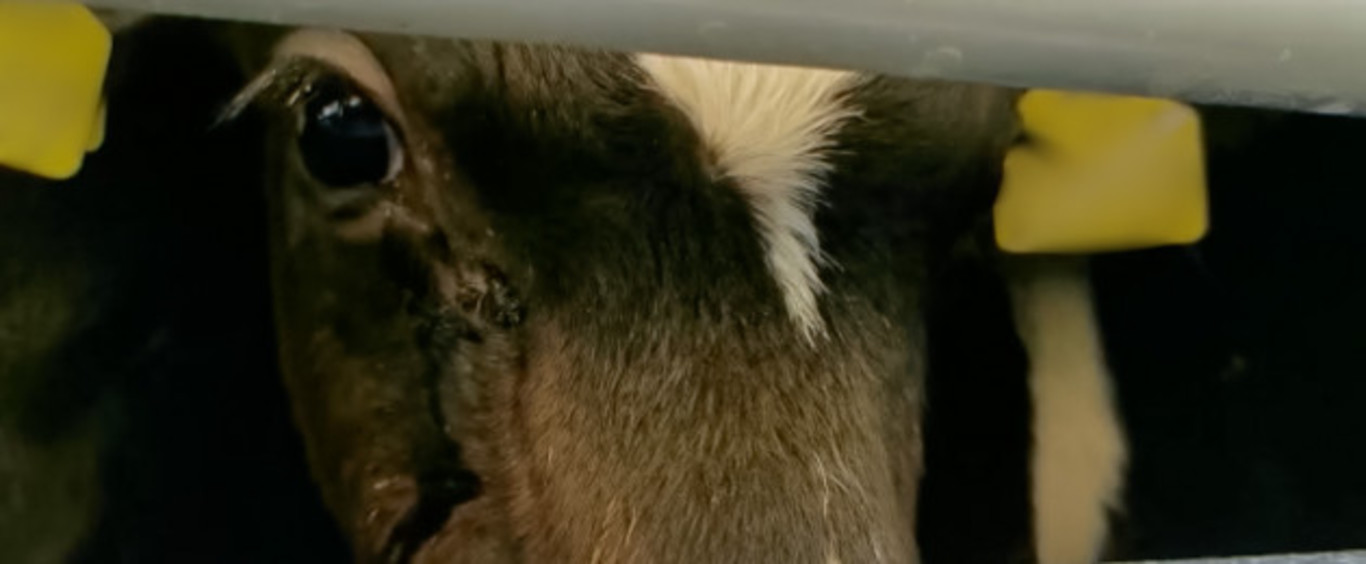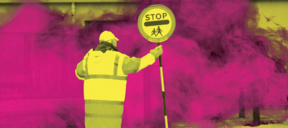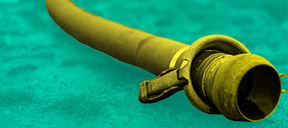‘Empty bellies’: Unweaned calves left without milk for long periods on journey to Europe
Department audit finds some operators not complying with feeding intervals, Noteworthy reveals.

—
“IT MUST BE a nightmare for them.”
This is how Lesley Moffat of Eyes on Animals envisioned the experience of unweaned calves – still dependent on milk – she saw for sale this year at Irish marts.
“That must have been extremely scary and intimidating. They don’t really know how to walk and there’s a lot of rushing and noise,” she said, opening them up to stress, on top of the potential to pick up illness as their immune system is not fully formed at this young age.
This is just the first leg of a long journey across land and sea in the Irish live export trade that the Government, Bord Bia, the live export industry and the country’s leading farming representative groups are all adamant adheres to the highest welfare standards in line with national and EU law.
Moffat’s organisation and other animal welfare groups, however, have long criticised the Irish trade that they say is incapable of ensuring the welfare of unweaned calves as young as 15 days of age, even with the greatest of rules on paper, due to the length of the journey.
Investigations by several of the groups, including up to as recently as earlier this year, have documented long journey times, unweaned calves going unfed for longer than allowed under EU rules, as well as abuse of calves at French resting points, among other welfare issues.
As part of our TRADE OFF series, we examined these claims, as well as speaking to industry insiders, veterinary experts, farming bodies and State officials about the export trade, why it is needed, and what solutions, if any, can be offered to limit welfare concerns raised.
- Part one of this series revealed that thousands of Irish cattle are being sent to North Africa through Spain on lower standards vessels than allowed under Irish law. Part two investigated the fate of cattle exported outside of the EU on long sea journeys.
 Calf inside a truck being transported to mainland Europe
Calf inside a truck being transported to mainland Europe
Dairy calf explosion
“We have a tremendous natural starting advantage.” This is how the Minister for Agriculture described the dairy industry in July due to our grass-based production system, with dairy cow numbers now standing at 1.5 million – a 21% increase since the removal of the milk quota in 2015.
The rapid expansion has, however, created a headache for the sector – the hundreds of thousands of male calves born every spring that cannot produce milk and are of no value to farmers.
A shift in breeding means many calves raised are not well suited for the beef industry, with around 150,000 unweaned calves now exported to Europe every year.
This is where the natural advantage of our grass-fed system ends, however, and our geographic disadvantage as an island nation at the Western edge of Europe comes into play as calves must travel long distances by road and sea, mainly for fattening farms in Spain and veal farms in the Netherlands.
The live export industry is an important market for Irish farmers, stimulating price competition and providing alternative markets for the calves produced on the family farm, according to John Hallissey of the Irish Livestock Exporters Association. Dairy farmers themselves have identified the trade as the most effective option to manage numbers.
“We are the gateway to Europe for calves,” Hallissey said, with the welfare of the animal “our priority from start to finish”. With a financial interest at stake, exporters have to get the calves to their destination in “100% pristine condition”.
Standards are monitored by the Department of Agriculture (DAFM) that told us “Ireland demands the highest standards of animal welfare at every stage of the animal’s life including during transport”.
‘Inherently stressful’ transport
While recognising that there are strict rules on paper, Olga Kikou, the head of the European branch of Compassion in World Farming (CIWF), said her organisation “strongly believes” there should be a ban on exports “for the very fact that [Ireland] is an island and it takes so long to transport animals”.
“We are talking about very vulnerable animals in the beginning of their life when they haven’t developed a strong immune system,” she said, going long distances on lorries and ships without feed. “Anywhere else, these animals would be considered as very vulnerable.”
The Welfare of Farmed Animals Regulations requires that an animal must have access to feed at intervals appropriate to its physiological needs and that “calves shall be fed at least twice a day.”
It is not possible to feed the calves on lorries during the ferry journey from Ireland to France, with the European Commission finding that calves can only be successfully fed after unloading.
Brendan Smyth, the chair of Veterinary Ireland’s animal welfare committee, told Noteworthy that the organisation would have concerns “where these [feeding] needs are not being met”.
“The movement of animals is inherently stressful,” he said, with the organisation supporting the position of the Federation of Veterinarians in Europe (FVE) that animals should be transported as little as possible, reared close to where they were born, and slaughtered close to the point of production.
In line with this principle, he said, Veterinary Ireland supports the FVE’s call for the revision of EU transport legislation to prohibit the transport of young animals on journeys of greater than four hours.
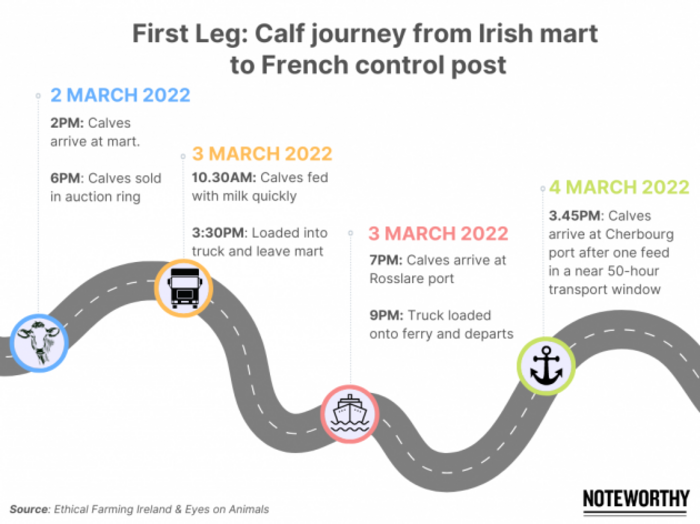
Under an exemption in EU animal welfare law, Irish calves can currently be transported for up to nine hours and then rested for at least an hour to be given liquid and fed. After this rest period, they can be transported for a further nine hours, known as the 9-1-9 period.
Once they get off the ferry, they must also be unloaded from trucks, fed, watered, and rested for 12 hours at, or close to, the port of destination.
The required feeding times are not being respected, however, claims Caroline Rowley of Ethical Farming Ireland, as the nature of the trade from Ireland means that calves will still be on the ferry after the 9-1-9 period has elapsed.
As the exemption applies to the journey time and not the feeding requirements, she said that EFI believes it is not possible to export unweaned calves without breaching the regulations. EFI has brought a High Court challenge against the State over this issue set for hearing later this year.
“Calves may be on a truck for some five hours, sometimes more, before the ferry to France leaves Ireland. This time includes loading onto the truck, the journey to the port, and waiting before the truck embarks on the ferry,” Rowley said.
“The ferry journey alone from Ireland to Cherbourg is 18 hours, add a couple of hours at either end and we’re now looking at up to 24 hours with no feed.
“Ireland is at a disadvantage geographically but that’s no excuse for compromising welfare,” Rowley said, adding that “the legislation is being ignored” as well as the first of the internationally accepted five freedoms of animal welfare – freedom from hunger.
 Calves inside of a transport truck going from Ireland to mainland Europe
Calves inside of a transport truck going from Ireland to mainland Europe
Documented cases of Irish calves
Using Freedom of Information, Rowley has accessed journey logs for various shipments that, she said, show cases of journeys in excess of times allowed before feeding is required. European NGOs have documented several of these cases in the past few years.
In 2016, CIWF and other groups tracked calves in transit from Ireland for more than 27 hours without access to feed. Two calves died before reaching the final destination. In 2018, Eyes on Animals documented the transport of calves from Rosslare to Cherbourg to a veal farm in The Netherlands. Calves were inside the truck for the first journey leg for 32 hours.
In another case documented by NGOs in March 2020, unweaned calves were in trucks for up to 29 hours during which time it is claimed they were not given milk or milk replacer. This case also uncovered abuse at the French control post, with undercover footage showing some calves being kicked at and hit repeatedly with a stick.
The previous year, in March 2019, Eyes on Animals also obtained footage of calves being beaten, kicked, punched and jumped on at another control post near Cherbourg. Soon after this, DAFM introduced a system to monitor calf transport bookings in a bid to prevent overcrowding at lairages [resting areas].
Earlier this year, Eyes on Animals and EFI, together with a Dutch MEP, investigated the transport of unweaned calves from Ireland to the Netherlands and Spain. They claim that calves were not fed during the 24 hour journey from the Irish mart to the first control post in France.
We asked the Department what action, if any, it has taken in these instances, however, it said that it does not comment on individual cases.
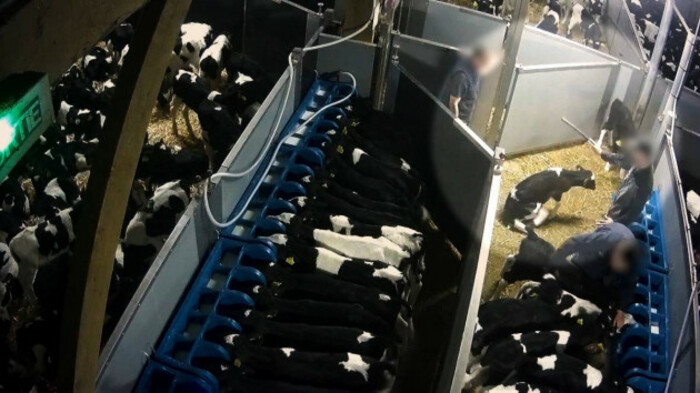 NGOs captured undercover footage of mistreatment of calves at a French resting post in 2019
NGOs captured undercover footage of mistreatment of calves at a French resting post in 2019
‘Rare events’ for the industry
While the Irish Livestock Exporters Association’s Hallissey accepts there is a certain level of stress involved during transport, he said Teagasc research has found that “those stress factors are back to normal within 24 hours after arrival in their destination farm”.
“We don’t get repeat business and we don’t get paid for dead, injured or damaged livestock. So we need to get our livestock to market in perfect condition,” he added, pointing to DAFM data that shows calf deaths during transport are extremely low.
According to the Department, mortality rates during transit are “orders of magnitude lower” than on farms, with rates in 2019 and 2020 below 0.1% of all calves exported.
The Irish Creamery Milk Suppliers Association (ICMSA) told us that Irish calves are “highly regarded” by the purchasers. “Customers would not buy calves if they were not in good condition,” a spokesperson said.
This was echoed by Eddie Punch, the general secretary of the Irish Cattle and Sheep Farmers’ Association (ICSA), who told us the key measure of how well calves are looked after “is the fact that buyers keep coming back for more”. He added: “There is no market for stressed or sick animals.”
Seamus McMenaminn, Bord Bia’s live export division lead, is of a similar view, telling us Ireland has an “excellent reputation” for supplying high quality, healthy cattle.
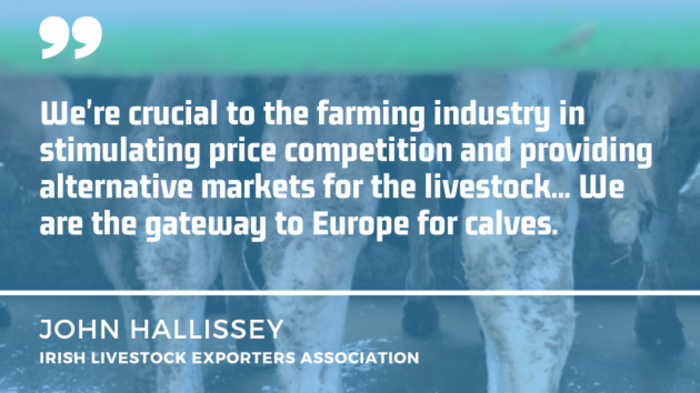
Enforcement issues arising
There have been enforcement issues in recent years, however, according to DAFM. At a hearing last February as part of a European Parliament inquiry into animal welfare during transport, DAFM’s director for animal welfare Rob Doyle said that it sent over 80 advisory warning letters and 17 legal letters in recent years, as well as suspending nine trucks and issuing one fixed penalty notice.
While he did not say why enforcement action was taken, records sent to the European Commission as part of an ongoing audit released through Freedom of Information go into more detail. Between 2018 and 2020, 153 cases of non-compliance with animal welfare rules were identified during checks at assembly points before calves go to the port, mainly concerning fitness and documentation issues.
Using journey logs and satellite navigation records, DAFM also takes retrospective action for issues identified during transit in Europe. Enforcement action taken, DAFM said, includes warnings, fines, suspensions of vehicles and driver certs, and permanent removal of transporter authorisations “in severe cases”. Since 2018, 24 approvals for transport have been withdrawn or suspended.
An internal audit carried out by DAFM’s Veterinary Internal Audit Unit in October 2020 also found that “some operators were not complying with the watering and feeding intervals, journey times and resting periods” as set out under EU law.
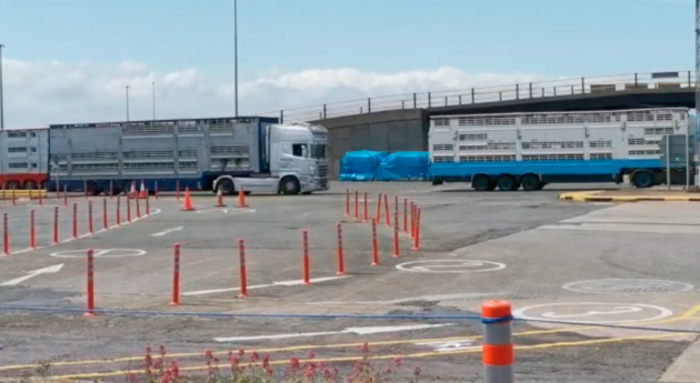 Trucks arriving at Rosslare port with calves
Trucks arriving at Rosslare port with calves
Industry aware changes are needed
While unfamiliar with any specific enforcement action, Hallissey said “it’s a necessity”. If someone is not meeting legal requirements, he said, “certainly, that guy is damaging our reputation and shouldn’t be allowed to be exporting”.
“It’s important to us that it is regulated because there’s guys that do a perfect job and their reputation is tarnished by those who use substandard methods,” he added.
While he is confident that the industry is highly regulated and adheres to high welfare standards, one of the key calves exporters to Europe, Seamus Scallan of the Wicklow Calf Company, also told us he does accept some of the concerns raised over feeding of the calves prior to arrival in France.
Scallan, who is also the welfare officer with another exporter group, the Irish Livestock Stakeholders’ Association, said the building of a lairage – a resting area for cattle or sheep – beside the ports at Rosslare and Dublin will help solve the feeding issue. He said that this is where calves could be fed slow releasing milk powder “which will last 14 or 15 hours”.
Scallan is involved in a project with Teagasc to trial new milk replacers, with results pending. “A milk replacer that has the ability to maintain calf blood glucose within the normal range for a longer period of time may be beneficial for calves during long-distance travel,” Teagasc said.
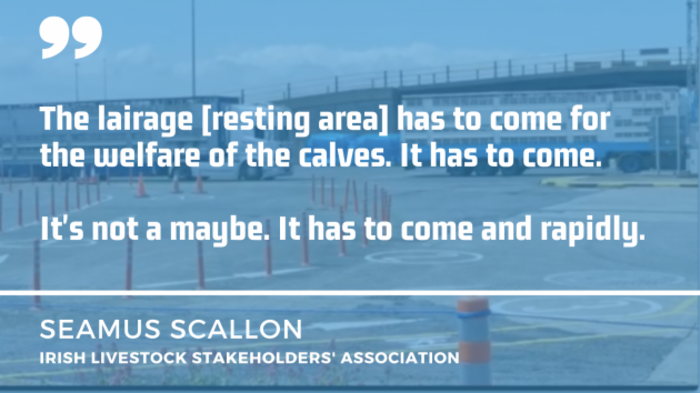
Hallissey of the Irish Livestock Exporters Association said that slow release milk powder is already fed by the majority of the exporters.
Animal welfare groups have questioned claims about long-lasting slow release milk feed, with Rowley stating that she has “seen no evidence of this” and, even with slow release formula, based on current journey times, “calves will still be hungry and have empty bellies”.
Whatever the position of welfare groups, Scallan is keen to push ahead with the lairage idea. So far, however, his attempts to get DAFM involved have failed despite meetings with the Minister for Agriculture and his officials. “I’m flogging a dead horse here trying to get ideas across the line.”
The Department told us it does not comment on engagement with individuals and that, “should an individual wish to open an assembly centre or control post, they can apply to DAFM who will inspect the premises for legislative compliance prior to approval”.
Scallan said his suggested changes, including increasing the age of calves at export, need to come fast as the sheer volume of calves born every year means that there will always be a need for an export market as we don’t have the capacity in the country for them.
If not exported, he said, the only option is to cull calves as young as 10 days old, an issue he sees as a much bigger welfare problem.
What future for the industry?
Scanlon is not the only one in and around the industry who recognises the need to change the system.
In a 2020 survey of almost 800 dairy farms, nearly 60% outlined concerns about the large number of male calves in the country, with many willing to make changes, including rearing male calves for beef production and establishing an Irish veal industry.
Teagasc’s DairyBeef programme kicked off this year to try and increase beef production from the dairy herd and a new sexed semen lab was set up last year to increase female dairy cow births.
These changes, however, will take years to come about, while the ICSA’s Eddie Punch told us that there is little indication that there is a domestic market to make an Irish veal industry viable.
While alternative solutions are being examined in Ireland to potentially shift a portion of the market away from exports, EU institutions are looking into stricter control of the industry. The European Parliament, for example, recently passed proposals to tighten up rules to protect calves during transport.
Some of the strongest proposals that would impact Ireland were defeated, with the top Irish farming groups all lobbying heavily against the proposed changes. The IFA, for example, argued changes would be devastating for the dairy sector and impact our competitive trade.
According to Lesley Moffat, however, Ireland’s status as an island nation with the need for ferry transport is “not an excuse” to push back against EU plans for stronger controls.
“You can not change the physiology of an unweaned calf. They should wait until they have fully developed immune systems… and even better is just keep them in Ireland until slaughter,” she said.
At the end of the day, according to CIWF’s Olga Kikou, there is one key factor that the farming sector and the Government is failing to take into account – “the ethical consideration” of the trade.
“Scientific knowledge has advanced a lot over the years and now we know very well how much these newborns actually suffer.”
—
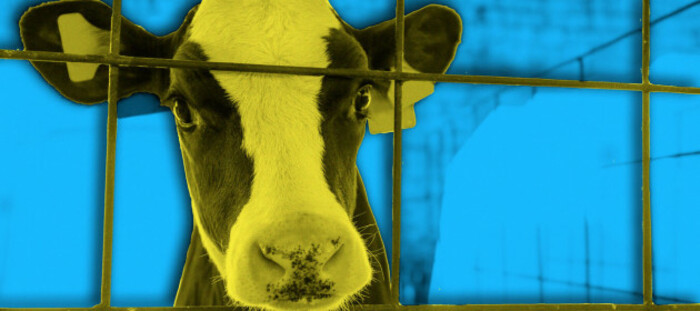
Our TRADE OFF investigation was carried out by Niall Sargent of Noteworthy. It was proposed and funded by readers of Noteworthy, the investigative journalism platform from The Journal.
You can support our work by submitting an investigation idea, funding a proposed project or setting up a monthly contribution to our general investigative fund HERE>>
We also have a number of other projects related to farming and animal welfare.

